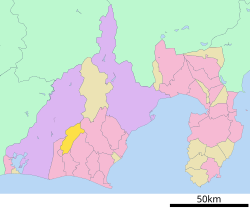Mori, Shizuoka
|
Mori 森町 |
|||
|---|---|---|---|
| Town | |||
| forest meaning | |||

Mori Town Hall
|
|||
|
|||
 Location of Mori in Shizuoka Prefecture |
|||
| Coordinates: 34°50′N 137°56′E / 34.833°N 137.933°ECoordinates: 34°50′N 137°56′E / 34.833°N 137.933°E | |||
| Country | Japan | ||
| Region |
Chūbu Tōkai |
||
| Prefecture | Shizuoka | ||
| District | Shūchi | ||
| Area | |||
| • Total | 133.84 km2 (51.68 sq mi) | ||
| Population (September 2014) | |||
| • Total | 18,606 | ||
| • Density | 139/km2 (360/sq mi) | ||
| Time zone | Japan Standard Time (UTC+9) | ||
| City symbols | |||
| • Tree | Camellia sasanqua | ||
| • Flower | Lily | ||
| • Bird | Common kingfisher | ||
| Phone number | 0538-85-2111 | ||
| Address | 2101-1 Mori, Mori-machi, Shūchi-gun, Shizuoka-ken 437-0293 | ||
| Website | Town of Mori | ||
Mori (森町 Mori-machi?) is a town located in Shūchi District, Shizuoka Prefecture, Japan.
As of September 2014, the town had an estimated population of 18,606 and a population density of 139 persons per km2. The total area was 133.84 km2.
Mori is located in an inland area in the hills of western Shizuoka Prefecture. The town has a temperate maritime climate with very hot, humid summers and mild, cool winters, pleasant air.
Mori has been known since the Kamakura period as the location of the Oguni Jinja, the ichinomiya of former Tōtōmi Province and a pilgrimage destination. In the Edo period it was largely tenryō territory under direct control of the Tokugawa shogunate. During the cadastral reform of the early Meiji period in 1889, the area was reorganized into Mori within Shuuchi District, Shizuoka Prefecture. In 1955-56, the area of the town was expanded through annexation of five neighboring villages. Discussions to merge with neighboring Fukuroi were shelved after a referendum opposing the merger was held in 2009.
The economy of Mori is mixed with industrial enterprise and agricultural enterprise. The main industries include automobile-related factories by Toyoda Gosei Co Ltd., and Yamaha Motor Company.
...
Wikipedia



